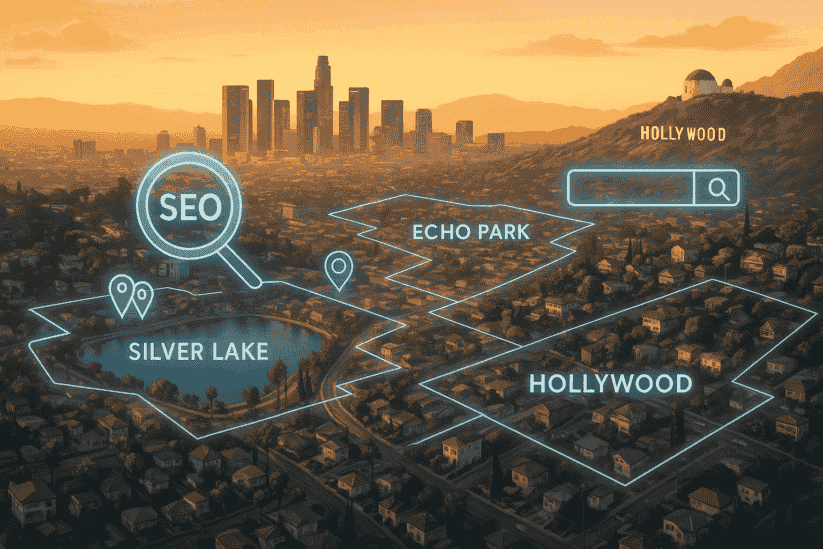Los Angeles is the second largest city in the U.S., made up of many small eclectic neighborhoods. Each has its own style and customers. Silver Lake a bit artistic. Echo Park is trendy.
Each area has a different digital market. Smart local businesses treat these neighborhoods separately. This helps them get targeted online visibility and better customers.
This guide shows how micro-neighborhood SEO can change your Los Angeles local SEO game. You’ll learn to connect with customers in their specific part of the city.
What Is Micro-Neighborhood SEO?
Why Each Neighborhood Is Different
Most local SEO strategy focuses on the whole city. But LA is special. A cleaning service in Venice Beach serves different people than one in Beverly Hills. Customers have different wants and search behavior.
Each neighborhood works like its own world. Silver Lake residents might use the search term “artisan coffee Silver Lake.” Manhattan Beach people look for “beachside café near pier.” These search queries show different markets that need different approaches.
The Power of Hyper-Local Keyword Targeting
Hyper-local keyword targeting means more than just using “Los Angeles” in keywords. You need to understand local language and landmarks that connect with each area’s people. This content strategy creates stronger bonds with customers. It puts you ahead of competitors who stick to city-wide tactics.
When you speak to a neighborhood’s identity, you build trust. Customers feel understood. They choose local businesses that know their local community.
Finding the Right Keywords
Research Local Search Terms
Learn how people in each area search for your services. Use Google Keyword Planner to find neighborhood terms. Look for patterns like “best pizza Echo Park” or “yoga studio near Griffith Observatory.”
Watch for local slang. People might search “WeHo restaurants” instead of “West Hollywood dining.” These small differences affect your LA neighborhood search visibility.
Long-Tail Keywords Work Best
Long-tail keywords are perfect for micro-neighborhood SEO. Instead of “Los Angeles dentist,” try “family dentist near Los Feliz Village.” These longer phrases have less competition. They bring motivated searchers.
Think about seasons too. “Halloween costumes Melrose Avenue” captures timely search intent.
Study Your Competition
Look at competitors in each neighborhood separately. A business might rank well city-wide but be weak in specific areas. These gaps are chances for your Silver Lake SEO strategy or Echo Park SEO marketing.
Check their specific content and keywords. Find neighborhoods with less competition.
Creating Great Local Content
Match Neighborhood Culture
Make specific content for each area’s personality. Write about local events and landmarks that matter to residents. A gym might create different content for health-focused Venice Beach versus family-friendly Pasadena.
This content creation approach builds authority. It shows you value the local community.
Use Landmark-Based SEO Content
Add famous landmarks to your specific content naturally. Mention Hollywood Walk of Fame, Griffith Observatory, or Santa Monica Pier. Include neighborhood spots like Silver Lake Reservoir.
Create landmark-based SEO content like “Pre-Concert Dining Near Hollywood Bowl.” This catches search queries from people planning activities at popular locations.
Cover Local Events
Write about neighborhood events. Cover Echo Park Rising music festival or Venice Beach Art Walk. This content attracts searches during busy times.
Document your community involvement through blog posts and photos. This builds local authority.
Optimize Google Business Profiles
Set Up Service Areas Right
If you serve multiple neighborhoods, set up your Google Business Profiles correctly. Define clear service areas. Make separate pages for each neighborhood.
Focus on areas where you can give great customer service from your physical location. This targeted approach gets better local search results than trying to cover everything.
Write Neighborhood Descriptions
Write descriptions that mention specific areas and landmarks. Instead of “Serving Los Angeles,” say “Proudly serving Silver Lake, Echo Park, and Los Feliz near Sunset Junction.”
A cleaning service might highlight “Historic home cleaning in Hancock Park.”
Add Local Photos
Upload photos showing your connection to neighborhoods. Include your storefront with local backgrounds. Show team members at local events.
These pictures strengthen your local presence.
Build Local Authority
Work with Local Groups
Partner with neighborhood associations and local charities. These partnerships create valuable backlinks. They strengthen your local relevance.
Sponsor little league teams. Support clean-up efforts. Share these activities on your website and social media platforms.
Partner with Local Businesses
Work with nearby businesses that complement yours. A coffee shop might partner with a bookstore. Working together opens the door to new content ideas and sends more visitors your way.
Connect with Local Media
Reach out to neighborhood blogs and local newspapers. Many LA areas have websites that cover local businesses.
Pitch helpful story ideas. Offer to write guest posts about your industry in specific neighborhoods.
Technical SEO for Multiple Areas
Build Landing Pages
Make separate landing pages for each neighborhood. Include local keywords and landmarks. Add neighborhood-specific SEO content that shows you understand each area.
Avoid copying content. Make each page unique with different information and customer reviews from local clients.
Use Schema Markup
Set up schema markup with neighborhood and landmark details. This helps search engines understand your location relevance. It improves your local search results visibility.
Include neighborhood addresses and service areas in your markup for better local search optimization.
Link Pages Together
Connect your neighborhood pages with smart internal links. Link from main service pages to neighborhood pages. Create topic groups around local themes.
This helps search engines understand your Hollywood neighborhood SEO content better.
Track Your Success
Monitor Each Neighborhood
Track rankings for neighborhood keywords separately. Monitor “Silver Lake coffee shop” different from “Echo Park café.” This shows performance in each digital market.
Use Google Analytics to see traffic by location and search queries. This helps you see which areas bring the most valuable visitors.
Watch Engagement
Monitor engagement in each neighborhood. Check social media platform interactions and customer review patterns.
Track which neighborhood-specific SEO content gets the most engagement. This guides future content creation.
Study Customer Data
See where your best customers come from. Some neighborhoods might bring more leads. Others might have higher-value customers.
Use this data to focus your efforts where they work best.
Advanced Tactics
Think About Seasons
Different neighborhoods have different busy seasons. Beach areas are busier in summer. Adjust your content strategy to match these patterns.
Make seasonal content calendars for each area’s peak times.
Optimize for Voice Search and Mobile Devices
People use voice search on mobile devices for local queries. They ask “Where’s the best sushi near the Grove?” Include question-based keywords in your content.
Make sure your site works well on phones and tablets.
Avoid Common Mistakes
Don’t Over-Target
Don’t make too many similar pages with little unique value. Quality beats quantity in Los Angeles local SEO strategy. Focus on neighborhoods where you can profoundly help customers.
Don’t claim service areas where you can’t provide good customer service. Search engines and customers will notice.
Keep Content Fresh
Don’t copy specific content across neighborhood pages. Each area deserves unique content that fits its character.
Learn each neighborhood’s culture before creating targeted content.
Case Studies: Real Success
Restaurant Success Story
A small restaurant chain used micro-neighborhood SEO in three LA areas. They made unique blog posts for each location. They partnered with local food bloggers. They optimized Google Business Profiles with local photos and customer reviews.
Results: 150% better search visibility and 85% more customers in six months.
Fitness Studio Win
A fitness studio used technical SEO across five LA neighborhoods. They made separate landing pages for each area. They used proper schema markup. They created content about local health trends.
Their online visibility improved dramatically. They got first result page rankings for over 50 local search terms. Sign-ups from targeted areas jumped by 200%.
Future-Proof Your Strategy
Stay Connected
Neighborhoods change. Your local SEO strategy should change too. Watch for new developments and demographic shifts that might affect search behavior.
Update your neighborhood-specific SEO content regularly to maintain local relevance.
Grow Smart
Expand to new neighborhoods slowly. Master a few areas first before adding more to your strategy.
Test new markets before investing heavily.
Dominating LA’s Neighborhood Search Game
Micro-neighborhood SEO is the future of local search marketing in densely populated cities like Los Angeles. Each neighborhood is a different digital market with unique search queries and culture. Local businesses that understand this gain an edge others can’t match.
Real growth starts by connecting with the community and knowing the details that make each area unique. Keep appearing consistently to build trust in every neighborhood you want to reach. Local businesses that master this connect better with customers and gain stronger online visibility than competitors using basic city-wide strategy.
Los Angeles isn’t just one city. Many communities exist. Each offers unique chances for businesses willing to invest in local relationships and search presence.
Start with one or two neighborhoods where you have connections. Then expand your strategy as you build authority.
Your customers aren’t searching for “Los Angeles” businesses. They want services in their specific part of the city.
Engage audiences in their context. Speak their local language. Watch your business become part of the neighborhoods you serve.
Frequently Asked Questions
What is micro neighborhood SEO for Los Angeles businesses?
Micro neighborhood SEO treats each LA neighborhood like Silver Lake, Echo Park, and Hollywood as separate markets. Instead of targeting “Los Angeles,” businesses optimize for specific areas with unique keywords, local content, and neighborhood-focused strategies.
How does hyper local keyword targeting differ from regular local SEO?
Hyper local keyword targeting uses specific neighborhood names, landmarks, and local slang. For example, “Venice Beach coffee shop” instead of “Los Angeles coffee.” This creates stronger connections with local customers and less competition.
Which Los Angeles neighborhoods should I target for my business?
Focus on neighborhoods where you can provide excellent customer service from your physical location. Start with 2 to 3 areas like Silver Lake, Echo Park, or Hollywood where you already have connections or expertise before expanding.
How do I optimize Google Business Profiles for multiple LA neighborhoods?
Create separate landing pages for each service area. Write neighborhood specific descriptions mentioning local landmarks. Upload photos showing your connection to each community. Set clear service boundaries in your profile.
What types of content work best for neighborhood specific SEO?
Create landmark based SEO content around local events, neighborhood culture, and community involvement. Write about Echo Park festivals, Silver Lake markets, or Hollywood attractions. Use blog posts, photos, and videos showing local engagement.
How can I track my micro neighborhood SEO success?
Monitor search rankings for neighborhood specific keywords separately. Use Google Analytics to segment traffic by location and search queries. Track engagement on social media platforms and customer reviews from each target area.
What are common micro neighborhood SEO mistakes to avoid?
How do I build local authority in specific LA neighborhoods?
Partner with local businesses, sponsor community events, and get involved with neighborhood associations. Create valuable backlinks through local media outreach and cross promotion with complementary businesses in each area.
Should I use schema markup for neighborhood specific pages?
Yes, implement schema markup with specific neighborhood and landmark references. Include local addresses, service areas, and business categories to help search engines understand your geographical relevance for better local search results.
How long does it take to see results from micro neighborhood SEO?
Most businesses see initial improvements in local search visibility within 3 to 6 months. Full results, including first page rankings for neighborhood specific search terms, typically take 6 to 12 months of consistent content creation and local engagement.


